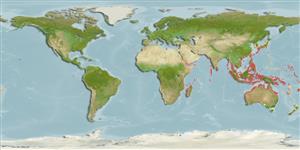>
Blenniiformes (Blennies) >
Blenniidae (Combtooth blennies) > Salariinae
Etymology: Istiblennius: Greek, istios = sail + Greek, blennios = mucus (Ref. 45335).
Eponymy: Jean-Jacques Dussumier (1792–1883) was a French merchant, collector, traveller and ship owner. [...] (Ref. 128868), visit book page.
More on author: Valenciennes.
Environment: milieu / climate zone / rango de profundidad / distribution range
Ecología
marino; salobre asociado a arrecife; rango de profundidad 0 - 3 m (Ref. 86942). Tropical
Indo-West Pacific. East Africa to Fiji, north to Taiwan, south to the Norfolk Island.
Tamaño / Peso / Age
Madurez: Lm ? range ? - ? cm
Max length : 12.0 cm TL macho / no sexado; (Ref. 2334)
Short description
Claves de identificación | Morfología | Morfometría
Espinas dorsales (total) : 12 - 14; Radios blandos dorsales (total) : 19 - 24; Espinas anales: 2; Radios blandos anales: 21 - 25. Dark spot distally between 1st 2 dorsal spines; (Ref. 4404). Males with about 6 dusky bands on body; females with bands that tend to form vertical rows of dusky spots; dusky spots on dorsal and caudal fins; anal fin uniformly dusky (Ref. 4404).
Body shape (shape guide): elongated; Cross section: oval.
Facultative air-breathing (Ref. 126274); Euryhaline. Adults are often found in mangrove areas (Ref. 9962). They inhabit sheltered rocky shorelines and mangroves (Ref. 37816). Oviparous. Eggs are demersal and adhesive (Ref. 205), and are attached to the substrate via a filamentous, adhesive pad or pedestal (Ref. 94114). Larvae are planktonic, often found in shallow, coastal waters (Ref. 94114).
Life cycle and mating behavior
Madurez | Reproducción | Puesta | Huevos | Fecundidad | Larva
Oviparous, distinct pairing (Ref. 205).
Springer, V.G. and J.T. Williams, 1994. The Indo-West Pacific blenniid fish genus Istiblennius reappraised: a revision of Istiblennius, Blenniella, and Paralticus, new genus. Smithson. Contrib. Zool. 565:1-193. (Ref. 9962)
IUCN Red List Status (Ref. 130435: Version 2025-1)
Threat to humans
Harmless
Human uses
Pesquerías: sin interés
Herramientas
Special reports
Download XML
Fuentes de Internet
Estimates based on models
Preferred temperature (Referencia
123201): 23.1 - 29.3, mean 28.5 °C (based on 2688 cells).
Phylogenetic diversity index (Referencia
82804): PD
50 = 0.5001 [Uniqueness, from 0.5 = low to 2.0 = high].
Bayesian length-weight: a=0.00776 (0.00356 - 0.01695), b=3.00 (2.81 - 3.19), in cm total length, based on LWR estimates for this (Sub)family-body shape (Ref.
93245).
Nivel trófico (Referencia
69278): 2.0 ±0.00 se; based on food items.
Resiliencia (Referencia
120179): Alto, población duplicada en un tiempo mínimo inferior a 15 meses (Preliminary K or Fecundity.).
Fishing Vulnerability (Ref.
59153): Low vulnerability (10 of 100).
🛈
Nutrients (Ref.
124155): Calcium = 153 [66, 272] mg/100g; Iron = 0.793 [0.431, 1.467] mg/100g; Protein = 18.2 [17.0, 19.4] %; Omega3 = 0.0743 [, ] g/100g; Selenium = 16.7 [7.3, 39.3] μg/100g; VitaminA = 103 [26, 392] μg/100g; Zinc = 3.01 [1.92, 4.68] mg/100g (wet weight);
